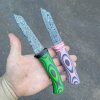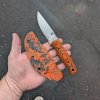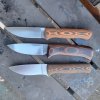- Joined
- Oct 6, 2016
- Messages
- 46
So first post but have a micarta question (I did do some searching here, but didn't find the answer).
I am brand new to knife making and ordered a good deal of micarta for some knives I'm making. I own four or five micarta handled knives and it seems like the texture on the scales is from the fabric in the micarta - i.e. the texture matches where the threads are in the material. The micarta I received is all super slick, which makes sense of course. The texture on the knives I own does not seem to be simply from rough sanding, though I could be mistaken. When you sand the micarta, can you get the texture to match the fabric by applying an oil or something, similar to raising the grain in wood before final sanding? I ordered some scales for a Bugout and I can track the texture with my fingernail and it matches the threads. How do you do that? Or are these micartas made without impregnating the top layer with so much epoxy?
I am brand new to knife making and ordered a good deal of micarta for some knives I'm making. I own four or five micarta handled knives and it seems like the texture on the scales is from the fabric in the micarta - i.e. the texture matches where the threads are in the material. The micarta I received is all super slick, which makes sense of course. The texture on the knives I own does not seem to be simply from rough sanding, though I could be mistaken. When you sand the micarta, can you get the texture to match the fabric by applying an oil or something, similar to raising the grain in wood before final sanding? I ordered some scales for a Bugout and I can track the texture with my fingernail and it matches the threads. How do you do that? Or are these micartas made without impregnating the top layer with so much epoxy?



